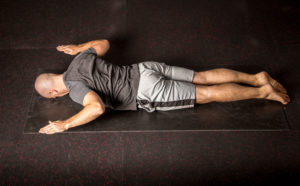As a swimmer there is a good chance that you will perform around 2-3,000 strokes the next time you jump into the water. To be able to handle that load effectively you need to develop balance between shoulder stability and mobility.
A swimming-specific yoga practice can help create this balance through body awareness and mindful movement.
Areas to Focus on When Developing Shoulder Stability
Shoulder instability is a common challenge for many swimmers. In a 2015 presentation for USA Swimming Dr. Scott Rodeo (2012 US Olympic Team physician) revealed on the 2012 Olympic Team 29% of the athletes felt their shoulder(s) were unstable while 10% had been diagnosed with shoulder instability.
In the same presentation Dr. Rodeo specifies three areas swimmers should focus on to help prevent shoulder injuries:
- Rotator Cuff
- Specifically the subscapularis
- Scapular Stabilizers
- Serratus Anterior
- Rhomboids
- Lower trapezius
- The Core
- Low back
- Abdomen
- Pelvis
In this article we will focus on the scapular stabilizers.
When your scapular stabilizers are weak and there is a lack of awareness and control of the movements of the shoulder blades, which can result in:
- Stress the anterior capsule of the shoulder,
- Increase the possibility of rotator cuff compression, and
- Decreased neuromuscular performance of the shoulder (Paine 2013)
A swimming-specific yoga practice can help increase scapular stabilization by developing your awareness and understanding of functional movement as well as strengthening of your rhomboids, serratus anterior and the middle and lower trapezius.
Body Awareness for Shoulder Stability
A lot of dryland training focuses on gross motor patterns to develop strength and power. Because of this many athletes are unfamiliar with how to perform the specific movements of the scapula. Developing an understanding and awareness of these movements is an essential part of performing corrective and strengthening exercises effectively.
The following two movement exercises will take you through the different actions of the scapula.
Intentional Shoulder Rolls (Scapular Awareness and Control)
Benefits:
- Teaches the different movements of the scapula (shoulder blades)
- elevation, retraction, depression, protraction, upwards rotation and downwards rotation
- Develops greater awareness and control of the action of the scapula
Standing Snow Devils
*This is an easier version of this exercise that can be done in a prone position
Benefits:
- Increases strength and mobility in the shoulders
- Develops greater understanding and control of different movements of the shoulders including
- scapular retraction, elevation, depression, upwards and downwards rotation as well as internal and external rotation
Shoulder Stability Sequence
The following four poses targets the rhomboids, serratus anterior as well as the middle and lower trapezius. Using these poses in a sequence incorporates both scapular stability and core control.
This sequence should be done following the rhythm of a full breath at a slower speed to promote greater stability and control.
Down Dog
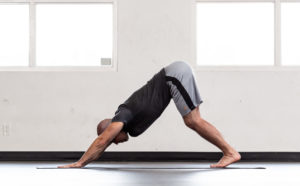
- Have the fingers spread wide and pointed straight forward
- Press strongly into your finger tips feeling like you are clawing the mat with your first knuckle
- Externally rotate your shoulders
- Twirl your triceps towards each other
- Point your elbow creases forward without changing the position of the hands
- Press the ground away from
- Actively lengthen your spine from the tailbone to the crown of the head
- Press your hips up and back in a diagonal direction forming the shape of an inverted ‘V’
- Start with your knees bent and gently press your heels towards the ground without forcing the legs straight
Plank Plus
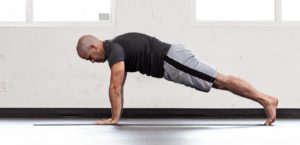
- From down dog on an inhale slowly glide forward into a plank position
- Fingers spread wide and pointed straight forward
- Shoulders over elbows and elbows over wrists
- Externally rotate your shoulders
- Your seat in line with the rest of your spine
- On an exhale press the ground away protracting the shoulder blades
- On the same breath bring your hips up and back coming into down dog
Chaturanga
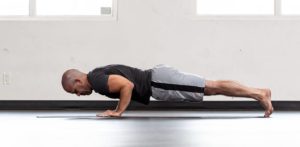
- On an exhale keeping your elbows tucked in towards your ribs and shoulders away from your ears slowly lower yourself towards the ground (a reverse push up) hovering a few inches off of the ground
Locust – Variation One
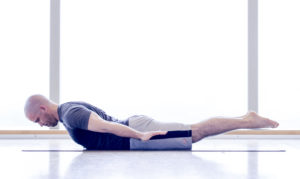
- From chaturanga come all the way down onto your stomach
- Look straight down with your nose hovering just off the ground, palms down with your big toes and legs together
- On an inhale hovering your palms and draw your shoulder blades towards your spine engaging the upper back
- Engage your glutei (the muscles in your seat) lifting the legs off the ground
- Reach your fingers towards your toes drawing the shoulder blades towards the hips
Locust – Variation Two
- From chaturanga come all the way down onto your stomach
- Look straight down with your nose hovering just off the ground, your arms in cactus (90° at the shoulders and elbows) with your big toes and legs together
- On an inhale slowly squeeze your shoulder blades towards your spine lifting the arms and the hands off the ground
- At the same time engage your glutei to slowly bring your legs just off of the ground
Locust – Variation Three
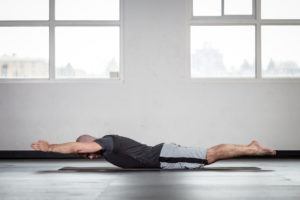
- Begin in locust pose (variation one)
- Slowly bring your arms out to the sides and then extend them overhead reaching in the opposite direction of the toes
- Your thumbs can be pointed up or palms can face straight down
*Press back up into down dog straight through a push up or on the knees through a table top (hands and knees) position.
…
References:
Paine, R and Voight, M. (2013) The Role of the Scapula. International Journal of Sports Physical Therapy, 8(5), 617-629. https://www.ncbi.nlm.nih.gov/pmc/articles/PMC3811730/.
Rodeo, S, M.D. (2015) “Shoulder Injury in Competitive Swimming: Strategies for Early Identification and Prevention” (PowerPoint presentation). Available at: https://www.usaswimming.org/docs/default-source/clinics/online-clinic-series/sports-med/4-15-15-evaluation-and-management-of-should-pain-in-swimmers—dr-scott-rodeo.pdf?sfvrsn=be9d5c32_4 (Accessed: 24 March 2021).
…
To learn more about how yoga can help your swimming performance sign up for our newsletter and join the Swimming-Specific Yoga Community
Visit our website swimminspecificyoga.com to take a 7 day free trial of the Swimming-Specific Yoga Online Studio membership.
With your membership you gain access to over 100 classes ranging from 15-60 minutes that have been created for the specific needs of swimmers.
